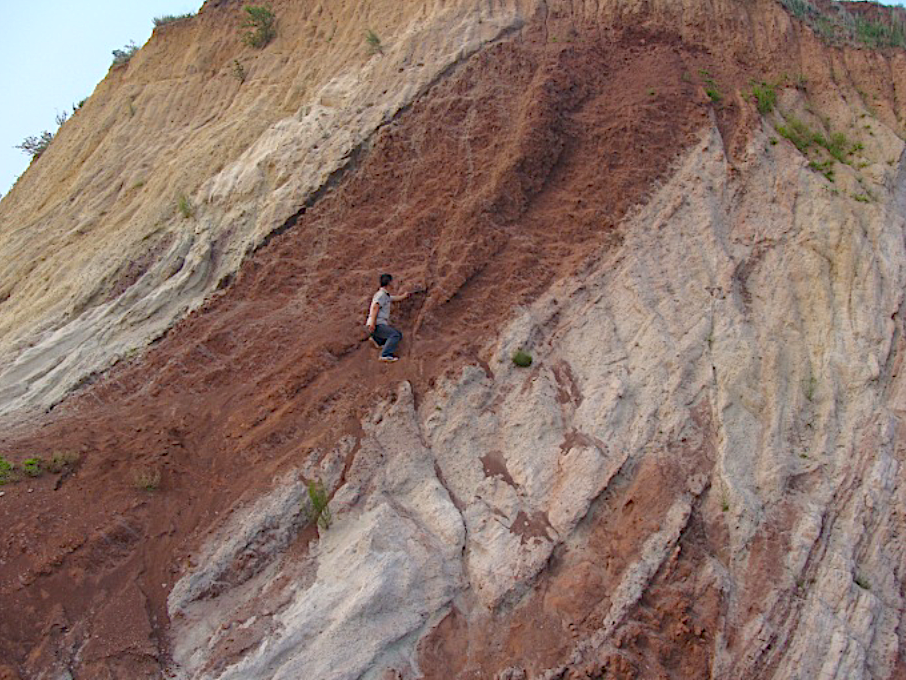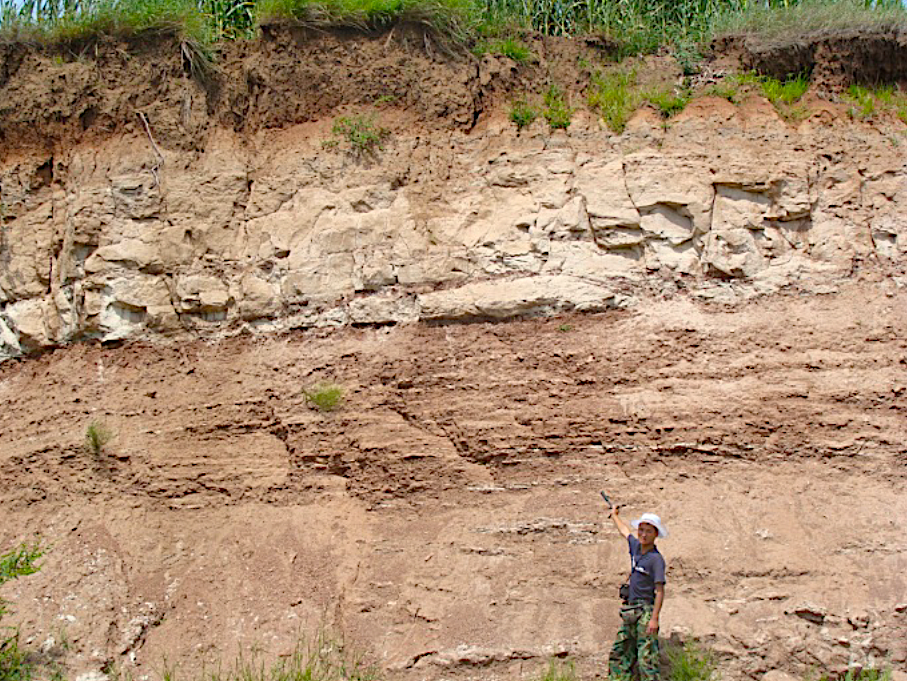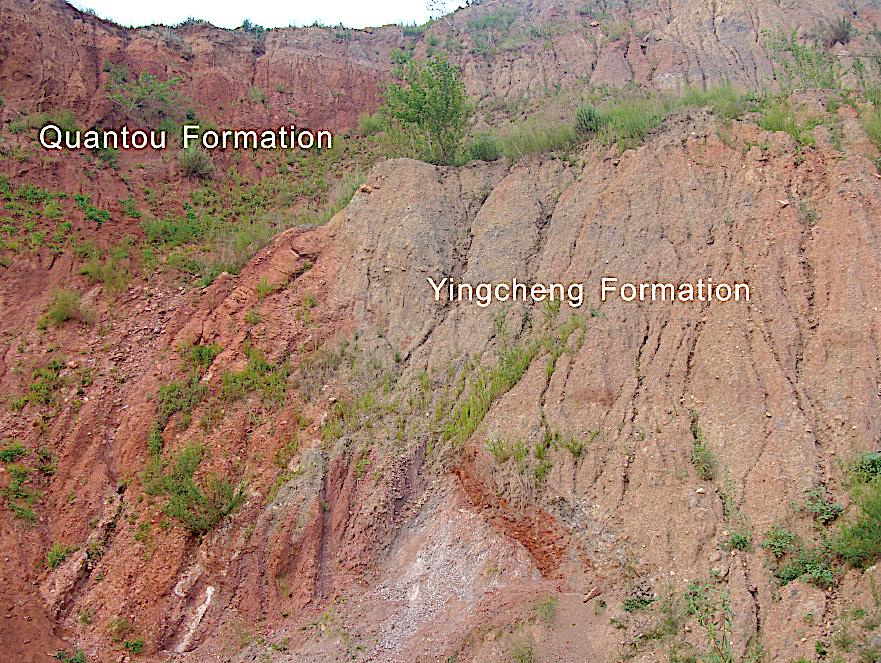Quantou Fm
Type Locality and Naming
Songliao Basin. Hat Jukichi erected the Quantou bed in 1927. The type locality for the designation is at Quantou of the Changtu county of Liaoning. The section for the designation is in Jijialing east of the Quantou railway station of the Changtu County, Liaoning. The reference section is down the well No.wu-1 at the Fengnian village of Fanrong of the Fuyu County of Heilongjiang. Lower formation (2 of 7) in the Songhuajiang Gr.
[Figure: Type section of Quantou Formation in Jijialing Village of Quantou Town, Changtu County of Liaoning]
Lithology and Thickness
The Quantou Formation is represented by red argillite interbedded with gray white and gray sandy rocks, with conglomerate at the base, which is divided from below upward into four members. First member is built up by purple red conglomerate, gray sandstone and variegated mudstone. Second member is purple red mudstone interbedded with gray and gray white sandstone. Third member is gray white sandstone and purple red clayey siltstone and mudstone with grayish green mudstone and sandy conglomerate. Fourth member is gray siltstone and fine sandstone, grayish green silty mudstone and purple red mudstone. It is 614.5 m thick.
[Figure: Upper part of Quantou Formation in Jijialing Village of Quantou Town, Changtu County of Liaoning]
Relationships and Distribution
Lower contact
The base of the formation is an unconformable contact marked by purple red and variegated and gray green sandy conglomerate is distinguished from the underlying Jurassic variegated conglomerate.
Upper contact
The top is a conformable contact marked by gray green fine sandstone and sandy mudstone is distinguished from black mudstone of the overlying Qingshankou Fm.
Regional extent
The present formation is widespread but overlain by the Quaternary. Around Dashanzuizi of the Dehui County, Jilin, its outcrops are built up by break red, purple and gray purple sandy conglomerate, gravel-bearing grit and siltstone, measuring 610 m in thickness, lying unconformably on the Jurassic. In Daan-Heidimiao-Huazijing-Sikeji of the Changling area, the Quantou Formation is fine in lithology and ranges from 100 to 120 m in thickness. From Heiyupao of Zhenlai to east of Taobaoxi of the Baicheng area, only the lower part of the formation developed, with a thickness of 60 m, and lies unconformably on the older strata. In the Nongan area, it is generally 700-800 m thick, and more than 2198.5 m down the well No. song-2. In the Yufu County, and Denglouku and Wanjinta of Qian Gorlos there appear conglomerate beds at the base of the formation, and it overlaps the old strata of different ages. On the southeast margin of the basin and in Jiutai and the Jilin small area, it is also exposed where it is relatively coarse in lithology and is less than 1000 m in thickness. In Heilongjiang, it is mainly distributed in the area south of the line linking Suiling, Beian, Dedu and Nahe. In the Lindian-Mingshui area of north Heilongjiang, the first member of the Quanshui Formation is dominated by variegated sandy conglomerate with sandstone and mudstone and overlaps the base of the basin, ranging from 78 to 440 m in thickness, locally in excess of 191.5 m. In the Daqing and Putaohua central depressions, the Quanshui Formation is in conformable contact with the Denglouku Formation, ranging from 78 to 440 m in thickness. In the depression of the uplift zone, it is seen to contain gypsum lumps and is in conformable or disconformable contact with the Denglouku Formation. The second member of the Quantou Formation extends slightly to the northern part of the basin. In the Keshan, Lindian and Mingshui area, it is generally 80-140 m thick and thins out towards the eastern and western sides and overlaps the base of the basin in the Keshan area; it is 119-284 m in Daqing and Putaohua, more than 320 m in Chaoyanggou-Fuguangtun of east Heilongjiang and less than 100 m in Chaoyanggou. The third and fourth members covered a larger area when deposited; more than 450 m at maximum in the Keshan County, decreasing in thickness towards both the eastern and western sides and mostly overlapping the strata prior to the Mesozoic towards the margins of the basin; in Hulan Ergi-Tailai in the western part of the basin, their lower parts are mostly intercalated with massive breccia and mudstone, with small amounts of conglomerate, ranging from 68.5 to 200 m in thickness; becoming thinner from east to west, 400-700 m thick in the central part, 529 m at maximum in the Putaohua area, quite thin in Renminzhen, only 282.5 m; in the eastern part of the basin, the third member is generally 340-450 m thick; the fourth member in the northern part is mainly built up by purple red and small amounts of gray green sandy mudstone, generally 60-80 m in thickness; in the western part the two members are represented by variegated mudstone and sandy mudstone interbedded with fine sandstone and grit, and thin out from east to west, 80-122 m thick in the central part; and in the eastern part, the two members are about 100 m thick.
GeoJSON
Fossils
Down the well No.du-402, it bears ostracods Cypridea (Morinia) gibbosa, C. (Morinia) adumbrata; down the well deng-24, Ziziphocypris simakovi; down the well No.Songji-6, estherias Bairdestheria songliaoensis; down the well No.nan-40, bivalves Plicatounio (P.) latiplicatus, Sphaerium cheintaoenses, Nippononia jiliensis; down the drillhole No.sui-17, floras Trapa? microphylla; down the well No.mo-7, Platanus nobilis; and down the well No. fu-122, sporopollen grains, the Cicatricosisporites-Tricolpopollenites- Quantonenpollenites assemblage.
It yields plant mega- and microfossils, charophytes, conchostracans, ostracods, bivalves and the fresh-to brackish-water endemic Nyktericysta - Operculodinium dinocyst association, which is characterized by abundant species of Nyktericysta (the dominant taxon), including N. davisi, and Operculodinium, including O. multipinosum, and only present in the upper part of the formation. The bivalve fauna includes Trigonioides (Trigonioides) heilongjiangensis [=Nippononaia (N.) jilinensis, Trigonioides? changlingensis], Plicatounio (Latiplicatounio) subrhombicus, Sphaerium (Sphaerium) shantungense, S. (S.) coreanicum [=S. (S.) aff. wiljuicum, S. (S.) cf. wiljuicum], and probably Martinsonella curvata, M. martinsoni and S. (S.) tani. The lower part of the formation also contains the Pseudofrenelopsis – angiosperms flora assemblage.
Age
Depositional setting
It belongs to shallow lake-shoal-lake shore deposition.
Additional Information
Enhanced with Igor N. Kosenko, Jingeng Sha and Boris N. Shurygin (2021). Upper Mesozoic stratigraphy of Sikhote-Alin (Russian Far East) and northeastern China: Non-marine and marine correlations. Part 1: Upper Jurassic-Hauterivian AND 2. Barremian-Aptian. Cretaceous Research, 124: articles 104811 (https://doi.org/10.1016/j.cretres.2021.104811) AND 104812 (https://doi.org/10.1016/j.cretres.2021.104812)


